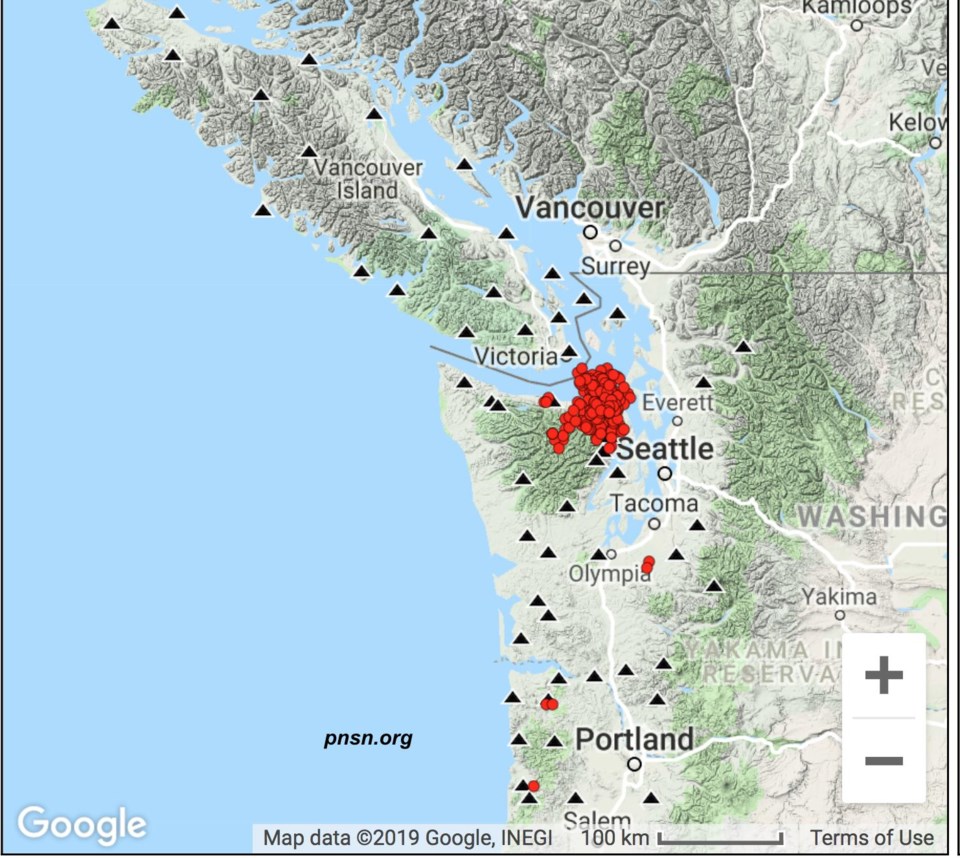It’s not the type of tweet you want to read just before bedtime.
“Several hundred tiny tremors (not felt) between Victoria and Seattle in the past 24 hours,” Earthquake guy posted Tuesday night. “Possibly the start of an early ETS? Stay tuned.”
Earthquake guy, better known as Natural Resources Canada seismologist John Cassidy, said it will take a few days to see if the cluster of 200 to 300 tiny tremors is an ETS, a process known as episodic tremor and slip, or a little burst of tremors that will last for a few days and disappear.
An ETS would mean B.C. is heading into a riskier seismic season, Cassidy said Wednesday.
“ETS are not felt. They are not even earthquakes,” he explained. “They are shaking events that we can record and locate. Typically, we get ETS events in this area every 14 or 15 months and they last for several weeks.”
During that time, the Cascadian subduction zone, which runs from Vancouver Island to northern California, experiences a slow slip.
“It does increase in a very, very, slight way the risk of a major earthquake,” Cassidy said.
“What we’re seeing now is just the tremors. If it becomes one of these ETS events when Vancouver Island slips to the west, we are nudging a locked fault zone beneath the ocean just west of Vancouver Island. That’s where the subduction fault is locked and storing energy. So you’re adding a little bit of stress to that locked fault.”
Vancouver Island is normally moving slowly toward the mainland. Each year, for a two-week period, it changes direction and moves back toward the ocean a few millimetres, Cassidy said.
The last ETS event on Vancouver Island took place in June.
Cassidy likens the increased risk to driving in busy traffic compared with driving on a quiet road.
“You have a slightly higher chance of getting in a car accident,” he said.
ETS events show a distinct pattern of movement in the region from Puget Sound to Port Alberni, he said. “The tremors will often start on the Olympic Peninsula and move north past Victoria, past the Cowichan Valley and up to Port Alberni. That’s quite a typical pattern. You will see a lot of tremors over a couple of weeks.”
The key point, Cassidy emphasized, is that ETS events happen all the time. They occur deep below Earth’s surface along faults that form the boundaries of tectonic plates.
“We don’t feel it because it’s all too slow,” he said. “It’s quite different from an earthquake where you have a sudden jolt. This is like a wind noise that builds up slowly and drops off slowly, or like a train approaching. The energy builds up and it levels off and rolls off slowly. It’s very different from an earthquake recording.”
ETS events frequently take place at different times in California, Oregon, southern Washington, Victoria or northern Vancouver Island, Cassidy said.
“To me, it’s a really important reminder that we live in an active earthquake zone,” he said, adding that the events are scientifically important.
“We’re still learning a lot about these events and what they mean. They have been very useful to help us find out where energy is being stored for future earthquakes and to better understand what we can expect in the future in terms of the ground shaking.”
Cassidy said there are tiny earthquakes every day that people don’t feel. Earthquakes large enough to cause damage are decades apart, he said, while huge earthquakes offshore are centuries apart.
Every day we are one day closer to a big earthquake, he said.
“We’ve had very large earthquakes in the past and we will again in the future. We know it will happen in this region. We just don’t know when.”



